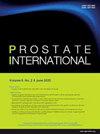Skin rash in metastatic hormone sensitive prostate cancer patients treated with apalutamide: a retrospective multicenter study in Korea
IF 2.6
2区 医学
Q2 UROLOGY & NEPHROLOGY
引用次数: 0
Abstract
Background
Skin rash is a common adverse event in patients with metastatic hormone-sensitive prostate cancer (mHSPC) treated with apalutamide. This study aims to investigate the incidence rate of skin rash and the predictive value of inflammation markers for skin rash in real-world Korean patients.
Materials and Methods
We conducted a retrospective analysis of patients with prostate cancer (PCa) who received apalutamide across 18 institutions in Korea, with a follow-up period of at least three months. A total of 218 patients were evaluated.
Results
Among the 214 patients analyzed, 78 (36.4%) developed a skin rash. The severity of the rash was classified as grade 1 (G1) in 27 patients (12.6%), grade 2 (G2) in 29 patients (13.5%), and grade 3 (G3) in 22 patients (10.3%). The median time to onset of any skin rash was 65.5 days (interquartile range, IQR 31.0-88.0). The monocyte-to-lymphocyte ratio (MLR) and systemic immune-inflammation response index (SIRI) were significantly higher in the G2 plus G3 group compared to the no rash plus G1 group (p=0.006, p=0.013, respectively) before apalutamide treatment. After 3 months, platelet-to-lymphocyte ratio (PLR) and SIRI were significantly higher in the G2 plus G3 group compared to the no rash plus G1 group (p=0.010, p=0.025, respectively)
Conclusions
In a real-world cohort of Korean patients, skin rash occurred in 36.4% of cases, with a median time to onset of 65.5 days. Grade 3 skin rash developed in 10.3% of cases. While MLR and SIRI were significantly higher in the G2 plus G3 group, these markers cannot be considered reliable predictors due to a low area under the curve (AUC < 0.7) before apalutamide treatment. However, increased levels of PLR, SII, and SIRI could potentially be useful for monitoring for the risk of severe rash development in these patients.
用阿帕鲁胺治疗转移性激素敏感前列腺癌患者的皮疹:韩国的一项回顾性多中心研究
背景:在阿帕鲁胺治疗的转移性激素敏感性前列腺癌(mHSPC)患者中,皮疹是一个常见的不良事件。本研究旨在探讨现实世界韩国患者的皮疹发病率及炎症标志物对皮疹的预测价值。材料和方法我们对韩国18家机构接受阿帕鲁胺治疗的前列腺癌(PCa)患者进行了回顾性分析,随访期至少为3个月。总共评估了218名患者。结果214例患者中有78例(36.4%)出现皮疹。皮疹严重程度分为1级(G1) 27例(12.6%),2级(G2) 29例(13.5%),3级(G3) 22例(10.3%)。出现皮疹的中位时间为65.5天(四分位数范围,IQR 31.0-88.0)。在阿帕鲁胺治疗前,G2 + G3组患者的单核细胞/淋巴细胞比率(MLR)和全身免疫炎症反应指数(SIRI)明显高于无皮疹+ G1组(p=0.006, p=0.013)。3个月后,G2 + G3组的血小板与淋巴细胞比率(PLR)和SIRI明显高于无皮疹+ G1组(p=0.010, p=0.025)。结论在韩国患者的现实世界队列中,出现皮疹的病例占36.4%,中位发病时间为65.5天。10.3%的病例出现3级皮疹。虽然G2 + G3组的MLR和SIRI明显更高,但由于曲线下面积(AUC <;0.7)在阿帕鲁胺治疗前。然而,PLR、SII和SIRI水平的升高可能有助于监测这些患者发生严重皮疹的风险。
本文章由计算机程序翻译,如有差异,请以英文原文为准。
求助全文
约1分钟内获得全文
求助全文
来源期刊

Prostate International
Medicine-Urology
CiteScore
4.40
自引率
26.70%
发文量
40
审稿时长
35 days
期刊介绍:
Prostate International (Prostate Int, PI), the official English-language journal of Asian Pacific Prostate Society (APPS), is an international peer-reviewed academic journal dedicated to basic and clinical studies on prostate cancer, benign prostatic hyperplasia, prostatitis, and ...
 求助内容:
求助内容: 应助结果提醒方式:
应助结果提醒方式:


